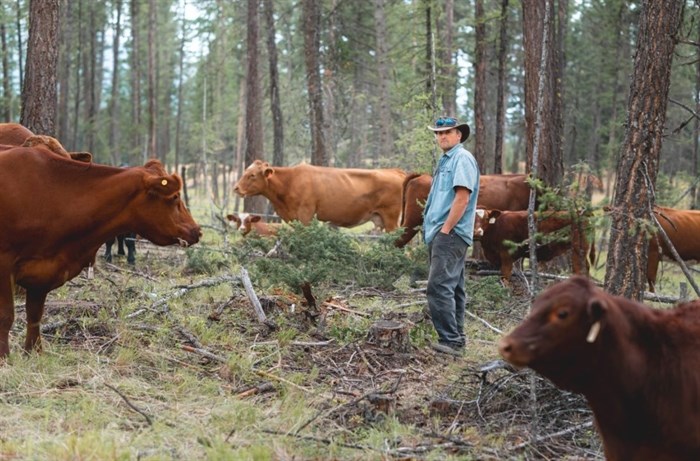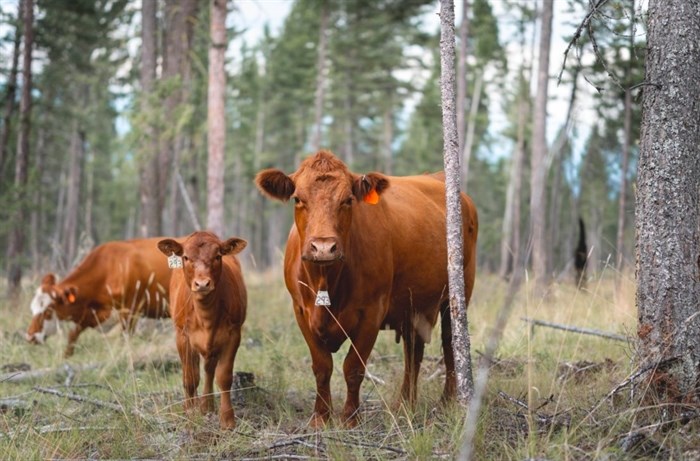
Jordy Thibeault with his cattle on a pilot project to mitigate wildfire risk near Cranbrook. Similar projects were run last spring near Peachland and Summerland.
Image Credit: Submitted/B.C. Cattlemen's Association
September 04, 2020 - 2:10 PM
Cattle are being tested to see if they can mitigate wildfire risks by grazing near four B.C. communities.
Over the past few years, ranchers have deliberately moved their summer grazing areas away from growing subdivisions to avoid conflicts with homeowners.
That changed for a few weeks this spring as ranchers near Peachland, Summerland and Cranbrook encouraged their cattle to move closer in.
“What we’re trying to do is to get those cattle to move back so they’re adjacent to the municipalities to work as mowers for us, or the people who are homeowners, to keep the grass down because grass is one of the most volatile fuel types that we have in B.C.," Mike Pritchard, fire prevention coordinator for the B.C. Cattlemen’s Association told iNFOnews.ca.
In recent years, much work has been done to thin forests near communities to lessen the risk of damage but, as the forest canopies have been opened up, more sunlight and rain get to the ground so grass is growing in areas where it rarely did before, increasing the fire risk.
Or, as with the 2018 Mount Eneas fire north of Summerland, the grass grows in the burnt area and provides fuel to help spread future fires.
The idea is to have the cattle munch on the new grass in interface areas near municipalities for four weeks in the spring, as was done for the first time this past June. The cows grazed from Wildhorse Road north of Summerland to Peachland’s southern boundary.
By grazing in the spring, the expectation is that the grass will not grow so tall, dry out and become a perfect fuel to spread fires in August.

Image Credit: Submitted/B.C. Cattlemen's Association
A similar project was done over a 13 kilometre stretch along the southern perimeter of Cranbrook. Another project is planned near Merritt next year and in a recently thinned area along June Springs Road in East Kelowna.
Results have been mixed. There was little impact in the Summerland and Peachland areas because it was such a wet spring that the grass seemed to grow right back but results are still being analyzed.
Cranbrook had its 10th driest summer on record and, it seems, the grazing was effective.
So, from a wildfire perspective, cattle grazing may prove to be a helpful tool, although more study and refinement is needed.
But, with the closer proximity to housing, the potential for conflicts with residents increases.
Pritchard has been working with homeowners to try to get them to buy into the idea of cattle grazing for free versus burning or mowing the grass.
But, so far, that has meant relatively expensive fencing. Traditional barbed wire fencing costs $20,000 a kilometre.
A new-style electric fence has also been tried. It uses a large strand of wire that people and wildlife can see and avoid rather than the older thin wires that elk and bear would just charge through and break.
The solution will likely be the adaptation of solar powered collars that are widely used in Europe.
Cows will be trained to react to a sound that warns them when they’re getting too close to their virtual fence. If they keep going, they’ll get an electric shock, similar to a dog collar.
That won’t be tried in the June Springs area because it’s a small site intermixed with housing. Pritchard doesn’t want to risk a backlash against the project if the collars don’t work and the cattle start trampling and munching on homeowners' gardens.
Instead, high-quality fencing is planned with good self-closing gates to keep the cattle enclosed for the three to four weeks they’re there, then the gates can be left open for easy public access the rest of the year.
While these pilot projects are focused on wildfire mitigation, both Thompson Rivers University in Kamloops and TELUS are getting involved to better use the full capacity of the collar technology.
The collars will be able to pinpoint individual cattle precisely so drones can be sent out to not only monitor the animal but to see what grasses are actually being eaten and, possibly, to direct them to more nutrient rich areas.
The collars could potentially be used to herd the cattle in the fall rather than sending ranchers out on horseback or all-terrain vehicles to bring them in or move them from site to site.
In Europe, Pritchard said, thousands of cattle are equipped with the collars and some are even kept in virtual corrals.
The added bonus is that they will cost about half the price of traditional fences.
To contact a reporter for this story, email Rob Munro or call 250-808-0143 or email the editor. You can also submit photos, videos or news tips to the newsroom and be entered to win a monthly prize draw.
We welcome your comments and opinions on our stories but play nice. We won't censor or delete comments unless they contain off-topic statements or links, unnecessary vulgarity, false facts, spam or obviously fake profiles. If you have any concerns about what you see in comments, email the editor in the link above.
News from © iNFOnews, 2020